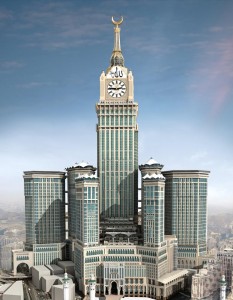Source: Composites World
The 607m tall Makkah clock tower, the central tower of the Abraj-Al Arab development in Makkah, Kingdom of Saudi Arabia, features more than 40,000-sq-m of advanced composite panels, and material supplied by Gurit.

Composites specialist Gurit (Isle of Wight, U.K.) reported on Jan. 23 that the recently inaugurated Makkah clock tower, the central tower of the Abraj-Al Arab development in Makkah, Kingdom of Saudi Arabia, features composite materials and structural engineering from the company.
At 607m/1,991 ft tall, the building is the second tallest in the world. The top 200m/656 ft of the tower is clad with more than 40,000m²/430,556 ft2 of advanced composite panels, including the largest clocks in the world — 43m/141 ft in diameter, with 23m/75.5 ft long minute hands. The cladding of the tower top includes intricate calligraphy and ornamental patterning, finished in glass and ceramic tiles. Illumination of the clock hands, clock faces and media wall, called for over two million LEDs to be integrated into the cladding panels.
Gurit worked closely with the tower top designers, SL-Rasch (Stuttgart, Germany), to carry out the structural engineering of the composite tower top cladding, clock hands, and the 23m diameter crescent, a self-supportive composite structure located at the top of the building. Gurit supplied a range of advanced composite materials to Premier Composites Technologies (Dubai, UAE), the company that carried out fabrication and installation of the cladding, clock face, clock hands and crescent. This included a new fire-retardant, wet-laminating system from Gurit, Ampreg 21FR, which was developed for lamination of the façade. Lamination was carried out on direct CNC cut molds fabricated using Gurit’s T-Paste tooling paste on a polystyrene blank block. The easy-machining, low-cure shrinkage and high level of detail achievable with T-Paste reportedly enabled rapid production of accurate direct molds for the part production.
The clock hands presented a particular challenge due to their long slender geometry and the potential for high wind loading. The clock hands were manufactured using Gurit’s WE91-2 carbon fibre prepreg material and Corecell T foam structural core. Gurit originally developed WE91-2 and Corecell T foam for use in large wind turbine blades. The stiffness-to-weight ratio of the carbon WE91-2 prepreg combined with the mechanical properties, toughness and low resin uptake of Corecell structural core enabled the realization of a lightweight, stiff clock hand. More info












